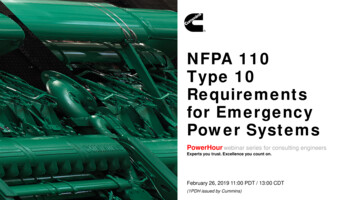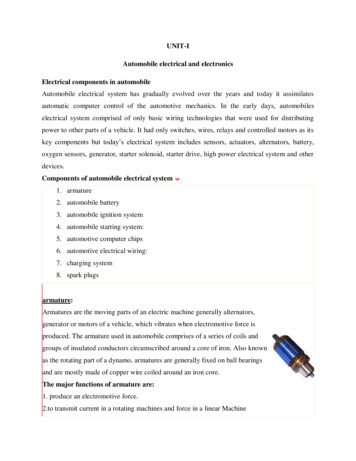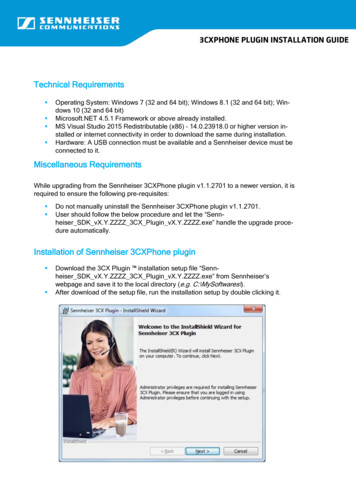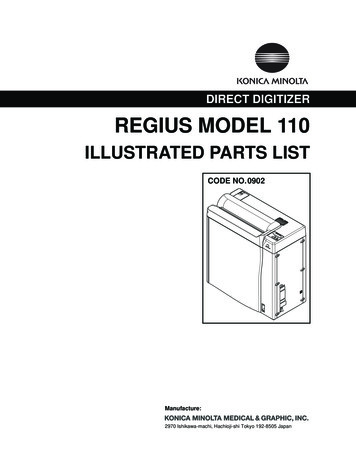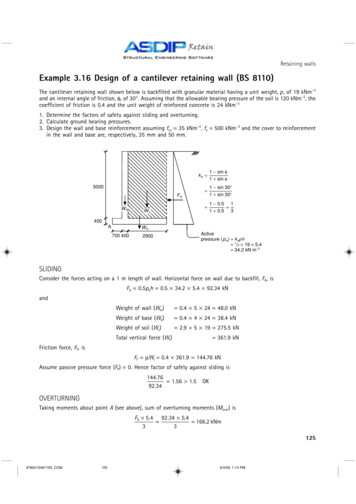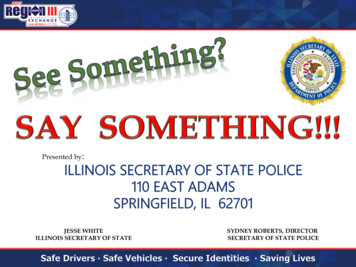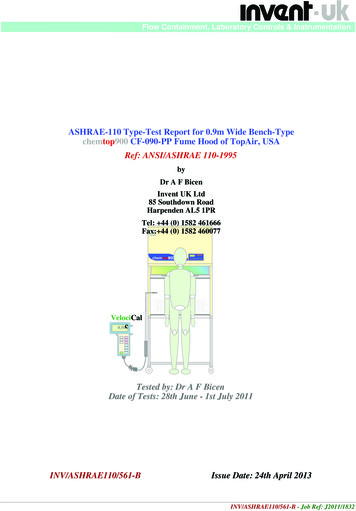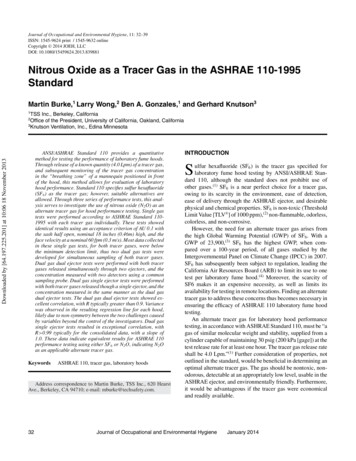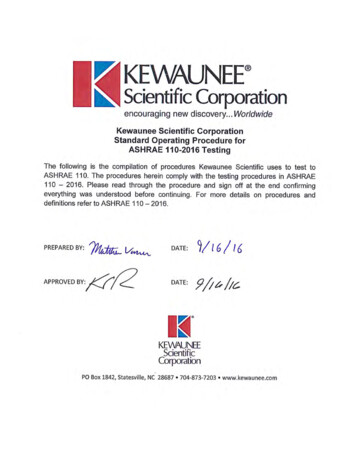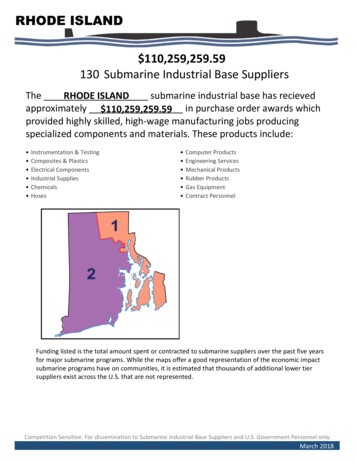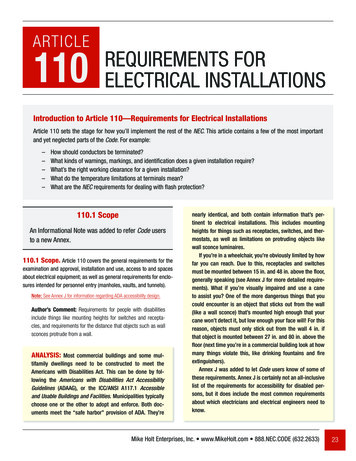
Transcription
ARTICLE110REQUIREMENTS FORELECTRICAL INSTALLATIONSIntroduction to Article 110—Requirements for Electrical InstallationsArticle 110 sets the stage for how you’ll implement the rest of the NEC. This article contains a few of the most importantand yet neglected parts of the Code. For example:–––––How should conductors be terminated?What kinds of warnings, markings, and identification does a given installation require?What’s the right working clearance for a given installation?What do the temperature limitations at terminals mean?What are the NEC requirements for dealing with flash protection?110.1 ScopeAn Informational Note was added to refer Code usersto a new Annex.110.1 Scope. Article 110 covers the general requirements for theexamination and approval, installation and use, access to and spacesabout electrical equipment; as well as general requirements for enclosures intended for personnel entry (manholes, vaults, and tunnels).Note: See Annex J for information regarding ADA accessibility design.Author’s Comment: Requirements for people with disabilitiesinclude things like mounting heights for switches and receptacles, and requirements for the distance that objects such as wallsconces protrude from a wall.ANALYSIS: Most commercial buildings and some multifamily dwellings need to be constructed to meet theAmericans with Disabilities Act. This can be done by following the Americans with Disabilities Act AccessibilityGuidelines (ADAAG), or the ICC/ANSI A117.1 Accessibleand Usable Buildings and Facilities. Municipalities typicallychoose one or the other to adopt and enforce. Both documents meet the “safe harbor” provision of ADA. They’renearly identical, and both contain information that’s pertinent to electrical installations. This includes mountingheights for things such as receptacles, switches, and thermostats, as well as limitations on protruding objects likewall sconce luminaires.If you’re in a wheelchair, you’re obviously limited by howfar you can reach. Due to this, receptacles and switchesmust be mounted between 15 in. and 48 in. above the floor,generally speaking (see Annex J for more detailed requirements). What if you’re visually impaired and use a caneto assist you? One of the more dangerous things that youcould encounter is an object that sticks out from the wall(like a wall sconce) that’s mounted high enough that yourcane won’t detect it, but low enough your face will! For thisreason, objects must only stick out from the wall 4 in. ifthat object is mounted between 27 in. and 80 in. above thefloor (next time you’re in a commercial building look at howmany things violate this, like drinking fountains and fireextinguishers).Annex J was added to let Code users know of some ofthese requirements. Annex J is certainly not an all-inclusivelist of the requirements for accessibility for disabled persons, but it does include the most common requirementsabout which electricians and electrical engineers need toknow.Mike Holt Enterprises, Inc. www.MikeHolt.com 888.NEC.CODE (632.2633)23
110.14 Requirements for Electrical Installations110.14 Conductor Termination and SplicingThe Informational Note was revised for accuracy.110.14 Conductor Termination and Splicing. Conductor terminal and splicing devices must be identified for the conductormaterial and they must be properly installed and used. Figure 110–1Figure 110–2Author’s Comments: See the definition of “Identified” in Article 100.Figure 110–1Author’s Comment: Switches and receptacles marked CO/ALR are designed to ensure a good connection through the useof a larger contact area and compatible materials. The terminalscrews are plated with the element called “Indium.” Indium isan extremely soft metal that forms a gas-sealed connection withthe aluminum conductor.Connectors and terminals for conductors more finely stranded thanClass B and Class C, as shown in Table 10 of Chapter 9, must be identified for the conductor class. Figure 110–2Author’s Comment: According to UL Standard 486 A-B, aterminal/lug/connector must be listed and marked for use withother than Class B stranded conductors. With no marking or factory literature/instructions to the contrary, terminals may only beused with Class B stranded conductors.24Mike Holt’s Illustrated Guide to Changes to the NEC 2014 Conductor terminations must comply with the manufacturer’s instructions as required by 110.3(B). For example, ifthe instructions for the device state “Suitable for 18-12 AWGStranded,” then only stranded conductors can be used withthe terminating device. If the instructions state “Suitable for18-12 AWG Solid,” then only solid conductors are permitted,and if the instructions state “Suitable for 18-12 AWG,” theneither solid or stranded conductors can be used with the terminating device.Copper and Aluminum Mixed. Copper and aluminum conductorsmust not make contact with each other in a device unless the deviceis listed and identified for this purpose.Author’s Comment: Few terminations are listed for the mixingof aluminum and copper conductors, but if they are, that will bemarked on the product package or terminal device. The reasoncopper and aluminum shouldn’t be in contact with each otheris because corrosion develops between the two different metalsdue to galvanic action, resulting in increased contact resistanceat the splicing device. This increased resistance can cause thesplice to overheat and cause a fire.Note: Many terminations and equipment are either marked with atightening torque or have the torque values included in the product’sinstructions.
Requirements for Electrical Installations 110.16Author’s Comment: Conductors must terminate in devicesthat have been properly tightened in accordance with the manufacturer’s torque specifications included with equipmentinstructions. Failure to torque terminals can result in excessiveheating of terminals or splicing devices due to a loose connection. A loose connection can also lead to arcing which increasesthe heating effect and may also lead to a short circuit or groundfault. Any of these can result in a fire or other failure, including an arc-flash event. In addition, this is a violation of 110.3(B),which requires all equipment to be installed in accordance withlisting or labeling instructions. Figure 110–3information as well, and, if it’s listed equipment, theseinstructions must be followed [110.3(B)]. Although it wouldn’tbe a Code violation to ignore torque values on equipmentthat isn’t listed, it probably wouldn’t be a good idea to do so.Most electrical fires don’t start in the middle of a raceway;they start at a termination of some sort. The importance ofproperly torquing terminations can’t possibly be overstated.110.16 Arc-Flash Hazard WarningMarking requirements have been relaxed and changeshave been made to correlate with other Code changes.110.16 Arc-Flash Hazard Warning. Electrical equipmentsuch as switchboards, panelboards, industrial control panels, metersocket enclosures, and motor control centers in other than dwellingunits that are likely to require examination, adjustment, servicing, ormaintenance while energized must be marked to warn qualified persons of the danger associated with an arc flash from short circuits orground faults. The marking can be made in the field or the factory,but it must meet the requirements of 110.21(B), and be clearly visibleto qualified persons before they examine, adjust, service, or performmaintenance on the equipment. Figure 110–4Figure 110–3Question: What do you do if the torque value isn’t provided withthe device?Answer: Call the manufacturer, visit the manufacturer’s Website,or have the supplier make a copy of the installation instructions.Author’s Comment: Terminating conductors without a torquetool can result in an improper and unsafe installation. If a torquescrewdriver isn’t used, there’s a good chance the conductorsaren’t properly terminated.ANALYSIS: Many pieces of equipment are, in fact, markedwith their tightening torque. This isn’t, however, the onlyplace that one might expect to find this information. Theinstructions that come with the product may contain thisFigure 110–4Mike Holt Enterprises, Inc. www.MikeHolt.com 888.NEC.CODE (632.2633)25
110.21 Requirements for Electrical InstallationsAuthor’s Comments: See the definition of “Qualified Person” in Article 100. This rule is meant to warn qualified persons who work onenergized electrical systems that an arc flash hazard existsso they’ll select proper personal protective equipment (PPE)in accordance with industry accepted safe work practicestandards.(B) Field-Applied Hazard Markings. Where caution, warning,or danger signs or labels are required, the labels must meet thefollowing:(1) The markings must use words, colors, or symbols that effectivelywarn personnel. Figure 110–5Note 1: NFPA 70E, Standard for Electrical Safety in the Workplace, provides assistance in determining the severity of potential exposure, planning safe work practices, arc-flash labeling, and selecting personalprotective equipment.ANALYSIS: Since the introduction of this section in 2002,it’s been changed every single Code cycle. The upside isthat it seems to improve every three years.The requirement for the marking to take place in thefield has been removed. It seems a bit silly that an installation can pass or fail an inspection based on who put thesticker on the equipment. If the sticker is present, and itprovides the necessary information, why should it benoncompliant?A reference to the new 110.21(B) has also been added.This new requirement contains information about signagein general, and will be discussed further in that section ofthis textbook.Lastly, Informational Note 1 has been revised to makethe Code user aware of the fact NFPA 70E contains requirements for arc-flash labeling as well.Figure 110–5Note: ANSI Z535.4, Product Safety Signs and Labels, provides guidelines for the design and durability of signs and labels.(2) The label can’t be handwritten, and it must be permanentlyaffixed to the equipment. Figure 110–6110.21 MarkingsNew requirements for field-applied labels have beenadded.110.21 Markings.(A) Manufacturer’s Markings. The manufacturer’s name, trademark,or other descriptive marking must be placed on all electrical equipment and, where required by the Code, markings such as voltage,current, wattage, or other ratings must be provided. All marking musthave sufficient durability to withstand the environment involved.26Mike Holt’s Illustrated Guide to Changes to the NEC 2014Figure 110–6
Requirements for Electrical Installations 110.24Ex to (2): Labels that contain information that’s likely to change canbe handwritten, if it’s legible.Author’s Comment: A permanently affixed sign would includea sticker, but not a piece of paper taped to the equipment.(3) The marking must be of sufficient durability to withstand the environment involved.ANALYSIS: In an effort to standardize the markingrequirements found in the NEC, this requirement has beenadded. Certainly most will agree that a typed sign is betterthan a handwritten one.There are several changes to the Code that require compliance with this section, but even without those changesthis rule still applies. For example, 110.16 includes astatement requiring compliance with this section. If thatstatement weren’t in 110.16, it wouldn’t make this ruleoptional.Some of the locations in which this rule applies are110.16, 110.22, 250.20 (although there’s no reference inthat section) 312.8, 404.6, 408.3, and many, many others.110.22 Identification ofDisconnecting MeansThis section was revised to require compliance with110.21(B).110.22 Identification of Disconnecting Means.(A) General. Each disconnecting means must be legibly marked toindicate its purpose unless located and arranged so the purpose isevident. The marking must be of sufficient durability to withstand theenvironment involved. Figure 110–7(C) Tested Series Combination Systems. Tested series-rated installations must be legibly field-marked in accordance with 240.86(B)and 110.21(B) to indicate the equipment has been applied with aseries combination rating.Figure 110–7ANALYSIS: With the addition of 110.21(B), several Coderequirements such as this one have been revised. Section110.21(B) requires that field-applied labels be permanently affixed, be suitable for the environment, and can’tbe handwritten. Because there are so many changes thatare similar to this, not all of them will be covered in thistextbook.110.24 Available Fault CurrentAn Informational Note has been added to inform theuser of the intent of this requirement.110.24 Available Fault Current.(A) Field Marking. Service equipment in other than dwelling unitsmust be legibly field-marked with the maximum available fault current, including the date the fault current calculation was performed,and be of sufficient durability to withstand the environment involved.Figure 110–8Note: The fault current markings required by this section are to ensurecompliance with 110.9 and 110.10. They’re not intended to be used forarc flash analysis. Arc flash hazard information is available in NFPA 70E,Standard for Electrical Safety in the Workplace.Mike Holt Enterprises, Inc. www.MikeHolt.com 888.NEC.CODE (632.2633)27
110.25 Requirements for Electrical Installationsthe breaker would trip faster than it really would (the higherthe fault current, the faster the overcurrent device opens).This false value could ultimately result in a lower level ofPPE, and put workers in a dangerous situation.110.25 Lockable Disconnecting MeansA new section provides the rules for lockable disconnecting means.110.25 Lockable Disconnecting Means. Where the CodeFigure 110–8(B) Modifications. When modifications to the electrical installationaffect the maximum available fault current at the service, the maximum available fault current must be recalculated to ensure the service equipment ratings are sufficient for the maximum available fa
Note 1: NFPA 70E, Standard for Electrical Safety in the Workplace, pro-vides assistance in determining the severity of potential exposure, plan-ning safe work practices, arc-fl ash labeling, and selecting personal protective equipment. ANALYSIS: Since the introduction of this section in 2002, it’s been changed every single Code cycle. The .
